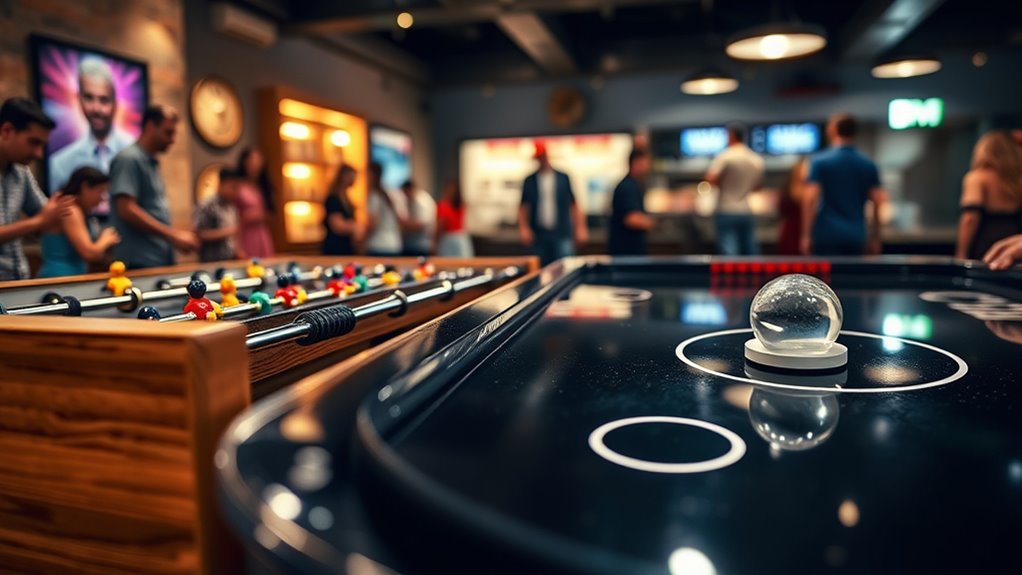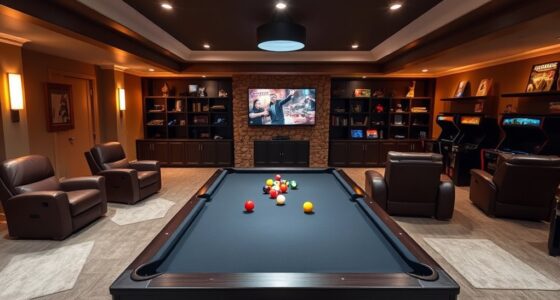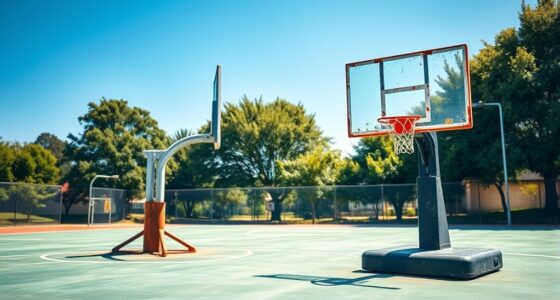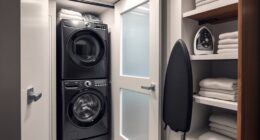If you enjoy fast-paced, adrenaline-pumping gameplay, air hockey might be your best pick with its quick puck speeds and rapid reflex demands. But if you prefer strategic control, precision, and longer gameplay sessions, foosball offers a satisfying challenge that sharpens motor skills and tactics. Both games have their unique appeal, so your choice depends on whether you prioritize speed or strategy. Keep exploring to find out which game table suits your style best.
Key Takeaways
- Air hockey offers fast-paced gameplay with high-speed puck movement, ideal for quick reflex players seeking adrenaline.
- Foosball emphasizes strategic control, fine motor skills, and longer engagement, appealing to players who enjoy planning and finesse.
- Air hockey tables are designed for speed and immediate reactions, while foosball tables focus on precision and tactical positioning.
- Electronic air hockey tables provide smoother, faster gameplay; foosball requires manual skill and strategic rod manipulation.
- The choice depends on whether players prefer energetic, rapid action or strategic, skill-based gameplay.
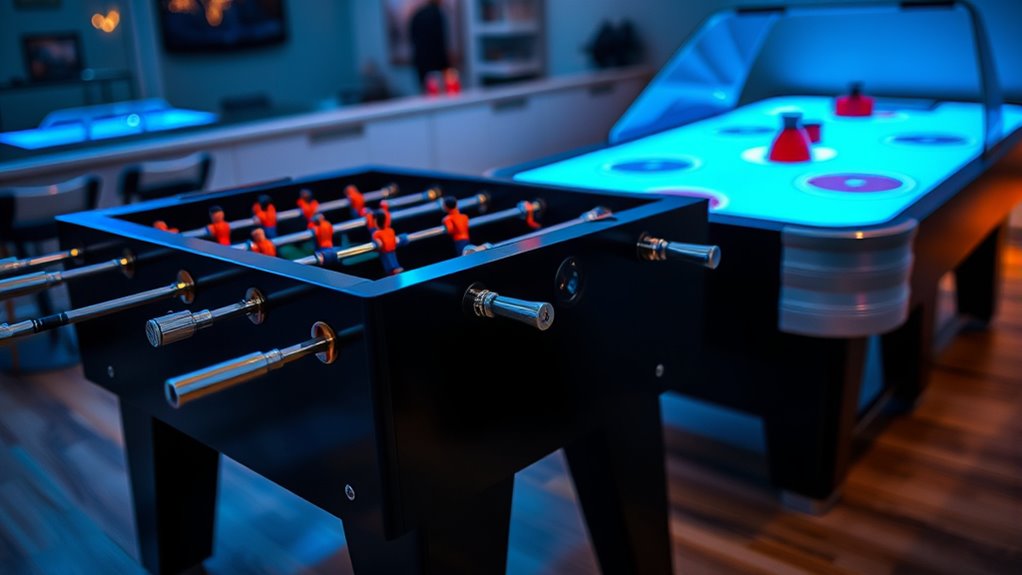
When comparing foosball and air hockey, both games offer fast-paced and engaging experiences, but they differ markedly in gameplay, mechanics, and skills required. Air hockey centers around a floating puck that glides effortlessly across a smooth surface, reaching speeds over 30 mph. Your goal is to quickly react, block incoming shots, and strike the puck back with a mallet, demanding rapid reflexes and keen hand-eye coordination. The game’s simplicity and speed make it accessible for beginners and young children, as the rules are straightforward and instinctual to grasp. The smooth, air-cushioned surface allows for swift puck movement, so you need to stay alert, anticipate your opponent’s moves, and make split-second decisions. Electronic tables boost puck speed with strong airflow, making gameplay even smoother, while manual tables rely on weaker fans, adding variability. Overall, air hockey emphasizes quick reactions and reflexes, sharpening your ability to make fast decisions under pressure. Air hockey tables can vary significantly in quality, with higher-end models offering more durable surfaces and better airflow systems to enhance gameplay.
In contrast, foosball involves controlling plastic or metal figures mounted on rods to maneuver and kick a ball into the opposing goal. Unlike air hockey’s speed-focused gameplay, foosball demands precision, strategic planning, and fine motor control. You must master the timing of rod movements, coordinate your wrist actions, and anticipate your opponent’s tactics to pass and shoot effectively. The control mechanics are more complex, requiring patience and practice as you develop skill over time. The game’s tactical nature encourages you to think ahead, set up passes, and execute well-planned shots, promoting strategic thinking and dexterity. While it’s accessible for a wide age range, mastering the nuances of rod manipulation offers a longer learning curve but provides increased engagement for players willing to develop their skills.
Both games improve mental engagement and motor coordination, though neither offers full-body exercise like running or weightlifting. Air hockey enhances quick decision-making and reaction speed, making it ideal for high-adrenaline gameplay. Foosball, however, fosters patience, strategic planning, and fine motor skills. Equipment varies: foosball tables typically measure around 150 cm by 90 cm with eight rows of figures, while air hockey tables feature smooth surfaces with air blowers for rapid puck movement. Electronic air hockey tables provide consistent airflow, improving gameplay smoothness, whereas manual tables depend on weaker fans. Bubble hockey combines elements of both, enclosed within a dome, adding unpredictability and complexity to puck play, suitable for various skill levels. Your choice depends on whether you prefer fast reactions and simplicity or strategic control and finesse—both offer fun, engaging experiences, but each table wins in different ways depending on what skills you want to develop.
Frequently Asked Questions
Which Game Table Is Better for Small Spaces?
When choosing a game table for small spaces, you need to take into account size, portability, and clearance. Air hockey tables, especially foldable or tabletop models, fit into tighter areas and require less room for gameplay. Foosball tables are bulkier and need more space for rod movement and player access. So, if space is limited, an air hockey table, particularly a compact or tabletop version, is generally the better choice.
How Much Maintenance Does Each Game Table Require?
You need to maintain both tables regularly to keep them in top shape. For foosball, weekly cleaning, quarterly checks, and annual deep cleans are essential, plus simple tasks like wiping and lubricating rods. Air hockey requires weekly cleaning of pucks and surface, along with checking screws and replacing worn parts. Both benefit from protective covers and careful placement to extend their lifespan and make certain smooth, responsive gameplay.
Are There Age Restrictions for Playing Either Game?
You might think both games are open to everyone, but age restrictions vary. For foosball, organizers often set minimum ages, like 12 or 18, with parental approvals for minors. Air hockey, however, usually has no formal age limits, making it more accessible. While casual play is broadly open, organized tournaments tend to implement rules to guarantee safety, especially for younger players.
Which Game Table Is More Popular Among Competitive Players?
You might notice that foosball is more popular among competitive players because it has a well-established global tournament scene, organized leagues, and increasing participation. Its structured competitions attract players of all skill levels, fostering a vibrant community. While air hockey is exciting and fast-paced, it’s less formalized and has a smaller competitive network. Overall, foosball’s extensive competitive infrastructure makes it the favored choice for serious players.
What Are the Safety Considerations for Each Game?
When considering safety, you need to look at features like rounded edges, stable construction, and enclosed parts. For foosball, guarantee rods are telescopic or fully enclosed, and the table has smooth corners to prevent injuries. For air hockey, check that the blower system is enclosed and the edges are cushioned. Both games should have non-tip bases and ergonomic handles to minimize risks like pinching, bruises, or tipping over.
Conclusion
Imagine stepping into a game room where foosball and air hockey sit side by side, each calling to you like old friends. I once challenged a friend to a match—she loved the fast pace of air hockey, but I couldn’t resist the strategic charm of foosball. Ultimately, both games have their magic, like two different beats in a song. So, whether you crave quick thrills or tactical fun, your perfect table awaits.
